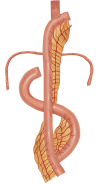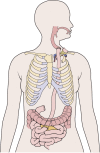Jejunal graft conduits after esophagectomy - PubMed (original) (raw)
Review
Jejunal graft conduits after esophagectomy
Puja Gaur et al. J Thorac Dis. 2014 May.
Abstract
Introduction: The jejunum is uniquely suitable for esophageal reconstruction because it is relatively abundant, does not require a formal preparation, is typically free of disease, has similar luminal size compared to the esophagus, has intrinsic peristalsis, and may not undergo senescent lengthening to the extent that colon does.
Methods: To obtain data to determine the outcomes of jejunal interposition for esophageal replacement, electronic databases were searched, including MEDLINE (Ovid SP), Scopus, EMBASE (Ovid SP), Science Direct's full-text database, and the Cochrane Library from January 1990 to September 2013.
Results: Two-hundred and forty-six abstracts were reviewed and an article search was performed on selected abstracts. Additional references from article bibliographies were included as appropriate. A thorough search of the literature demonstrates the widespread use of jejunum, either as a free, pedicled, or free- and pedicled-graft with acceptable results.
Conclusions: Any region of the esophagus can be replaced by jejunum, whether it is distal esophagus as a Merendino procedure for a vagal-sparing esophagectomy and segmental jejunal reconstruction connected to stomach, mid-thoracic esophagus as a pedicled jejunal interposition or free flap, cervical esophagus as a free segmental interposition, or the entire length as a long-segment super-charged pedicled jejunal interposition. When used, the jejunum is either pedicled, augmented ("super-charged"), a free segment (requiring microvascular anastomosis of artery and vein), or a combination of the above.
Keywords: Jejunum; conduit; esophagectomy; esophagus.
Figures
Figure 1
Merendino vagal-sparing esophageal replacement with jejunum.
Figure 2
Mid-thoracic esophageal replacement options.
Figure 3
Cervical free flap replacement of esophagus with jejunum interposition.
Figure 4
Long segment pedicled supercharged jejunal interposition.
Figure 5
Manometry of a jejunal long segment interposition.
Figure 6
Manometry of a colon long segment interposition.
Similar articles
- Reconstruction after esophagectomy for esophageal cancer patients with a history of gastrectomy.
Watanabe M, Mine S, Nishida K, Kurogochi T, Okamura A, Imamura Y. Watanabe M, et al. Gen Thorac Cardiovasc Surg. 2016 Aug;64(8):457-63. doi: 10.1007/s11748-016-0661-0. Epub 2016 May 27. Gen Thorac Cardiovasc Surg. 2016. PMID: 27234222 Review. - Long-segment, supercharged, pedicled jejunal flap for total esophageal reconstruction.
Ascioti AJ, Hofstetter WL, Miller MJ, Rice DC, Swisher SG, Vaporciyan AA, Roth JA, Putnam JB, Smythe WR, Feig BW, Mansfield PF, Pisters PW, Torres MT, Walsh GL. Ascioti AJ, et al. J Thorac Cardiovasc Surg. 2005 Nov;130(5):1391-8. doi: 10.1016/j.jtcvs.2005.06.032. Epub 2005 Oct 13. J Thorac Cardiovasc Surg. 2005. PMID: 16256794 - Super-Charged Pedicled Jejunal Interposition Performance Compares Favorably With a Gastric Conduit After Esophagectomy.
Stephens EH, Gaur P, Hotze KO, Correa AM, Kim MP, Blackmon SH. Stephens EH, et al. Ann Thorac Surg. 2015 Aug;100(2):407-13. doi: 10.1016/j.athoracsur.2015.03.040. Epub 2015 Jun 20. Ann Thorac Surg. 2015. PMID: 26101096 - Esophageal conduit necrosis.
Wormuth JK, Heitmiller RF. Wormuth JK, et al. Thorac Surg Clin. 2006 Feb;16(1):11-22. doi: 10.1016/j.thorsurg.2006.01.003. Thorac Surg Clin. 2006. PMID: 16696279 Review. - Supercharged pedicled jejunal interposition for esophageal replacement: a 10-year experience.
Blackmon SH, Correa AM, Skoracki R, Chevray PM, Kim MP, Mehran RJ, Rice DC, Roth JA, Swisher SG, Vaporciyan AA, Yu P, Walsh GL, Hofstetter WL. Blackmon SH, et al. Ann Thorac Surg. 2012 Oct;94(4):1104-11; discussion 1111-3. doi: 10.1016/j.athoracsur.2012.05.123. Epub 2012 Aug 29. Ann Thorac Surg. 2012. PMID: 22939245
Cited by
- Exploring the landscape of oesophageal discontinuity procedures and creation of cervical oesophagostomy in the modern era: a scoping review protocol.
Bondzi-Simpson A, Benipal H, Momoh H, Matei AC, Wakeam E. Bondzi-Simpson A, et al. BMJ Open. 2024 Jun 11;14(6):e081153. doi: 10.1136/bmjopen-2023-081153. BMJ Open. 2024. PMID: 38862230 Free PMC article. - First experience with a supercharged pedicled jejunal interposition for esophageal replacement after caustic ingestion in a middle-income Latin American country.
Alfaro-Pacheco R, Brenes-Barrantes R, Juantá-Castro J, Rojas-Chaves S, Echeverri-McCandless A, Brenes-Barquero P. Alfaro-Pacheco R, et al. Int J Surg Case Rep. 2023 May;106:108293. doi: 10.1016/j.ijscr.2023.108293. Epub 2023 May 6. Int J Surg Case Rep. 2023. PMID: 37167690 Free PMC article. - Efficacy of free anterolateral thigh flap and free jejunum in reconstruction for hypopharyngeal and cervical esophagus.
Wang S, Yang X, Peng X, Tang Q, Guo L, Tang X. Wang S, et al. Zhong Nan Da Xue Xue Bao Yi Xue Ban. 2022 Jul 28;47(7):888-894. doi: 10.11817/j.issn.1672-7347.2022.210763. Zhong Nan Da Xue Xue Bao Yi Xue Ban. 2022. PMID: 36039585 Free PMC article. Chinese, English. - Beware of gastric tube in esophagectomy after gastric radiotherapy: A case report.
Yurttas C, Wichmann D, Gani C, Bongers MN, Singer S, Thiel C, Koenigsrainer A, Thiel K. Yurttas C, et al. World J Clin Cases. 2022 Jun 16;10(17):5854-5860. doi: 10.12998/wjcc.v10.i17.5854. World J Clin Cases. 2022. PMID: 35979123 Free PMC article. - Overcoming Microsurgical Anastomotic Challenges in Supercharged Pedicled Jejunal Interposition for Pediatric Esophageal Reconstruction.
Yu JW, Wong FK, Thompson KM, Aycart MA, Francis A, Labow BI, Upton J, Taghinia AH. Yu JW, et al. Plast Reconstr Surg Glob Open. 2021 Aug 19;9(8):e3780. doi: 10.1097/GOX.0000000000003780. eCollection 2021 Aug. Plast Reconstr Surg Glob Open. 2021. PMID: 34667706 Free PMC article. No abstract available.
References
- Roux C.A new operation for intractable obstruction of the esophagus (L’oesophago-jejuno-gastrosiose, nouvelle operation pour retrecissement infranchissable del’oesophage). Semin Med 1907;27:34-40
- Longmire WP, Jr, Ravitch MM. A new method for constructing an artificial esophagus. Ann Surg 1946;123:819-35 - PubMed
- Binford RT, Jr, Cheraskin E. Clinical problems related to the tongue. Pediatr Clin North Am 1956:919-32 - PubMed
- Allison PR, Wooler GH, Gunning AJ. Esophagojejunogastrostomy. J Thorac Surg 1957;33:738-48 - PubMed
- Ascioti AJ, Hofstetter WL, Miller MJ, et al. Long-segment, supercharged, pedicled jejunal flap for total esophageal reconstruction. J Thorac Cardiovasc Surg 2005;130:1391-8 - PubMed
Publication types
LinkOut - more resources
Full Text Sources





